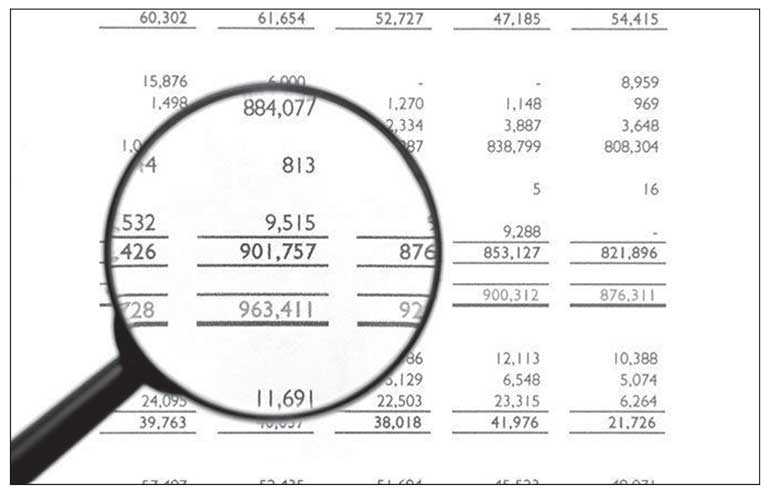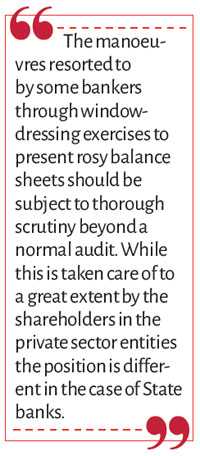Thursday Dec 12, 2024
Thursday Dec 12, 2024
Tuesday, 9 April 2019 00:00 - - {{hitsCtrl.values.hits}}

Public companies including banks are legally obliged to publish their audited annual balance sheets. We therefore see them appearing in the public media from time to time. For many of us such statements do not convey much information other than leaving some mind boggling questions that remain unanswered with matters to be clarified further. However for those knowledgeable in accounting practices and conversant with the art of analysing financial statements they fulfil the intended purpose in addition to the accomplishment of the legal obligation of the entity.

There is a growing concern about many areas affecting the financial conditions of a business not reflected in their published accounts and balance sheets due to the limitations of information making things rather incomprehensible to the stakeholders and the interested public. The management performance in relation to certain so called achievements of the past, though to the rest of us wonderful and sublime, may appear to others as they say, ‘rot’ or ‘balderdash’.
The interests and expectations arise mainly due to the limited information in relation to, for example, the objectives of the entity; its competitive standing; the nature of contracts entered into by the entity; nature of capital and other expenditure in a context of justifiability, necessity and priority; accrued commitments and liabilities, and the cash realisable true value of the assets, etc. etc. These concerns are of manifold importance when it comes to matters related to banking institutions in particular the State banks, primarily due to their large customer base and depositors who tend to rely and depend on the financial stability and the strength of the institution.
Hence in order to examine the veracity of this hypothesis of ‘the myths associated with balance sheets’, it would be prudent to focus attention on a published balance sheet of a banking institution. The most recently published audited statement of accounts of the People’s Bank is therefore chosen as a case in point to discuss this aspect in detail.
The People’s Bank being a 100% Government-owned entity, currently focused under the probabilities of being privatised/broad based/liberalised or being converted to a PPA, provides a good example for a case study of this nature. The bank published its annual statement of accounts only last week which appeared in the public print media. People’s Bank announced recently that they have been adjudged the best digitalised bank by ‘Asiamoney’ chosen by them for this year’s award. As the balance sheet does not disclose anything special about this success story, let us examine it in little more detail with emphasis on many related factors.
We are aware of banks establishing fully digitally operated branches from about a year ago, such as the digital division of CBC known as Flash, and the paperless fully digitalised branch NDB Neos.
The record of Asia Money Country awards in 2018 reveal the following: Best Bank: CBC; Best Corporate and Investment Bank: NDB Investment Bank; Best Digital Bank: HNB; Best for Premium Banking Services: CBC; Best Bank for SMEs: HNB; Best International Bank: HSBC; Best Bank for CSR: CBC; this year People’s Bank has been selected as the ‘Best Digital Provider’. Technically there is a big difference between being the ‘Best Digitalised Bank’ (as claimed by the PB) and a – ‘Provider of Digital Banking’ in many parts of the island through some of its branches scattered all over!
‘Best Digitalised Bank’ or ‘Provider of Digital Banking’?
Many banks in the country have played safe in providing digital platforms to their customers due to several reasons. Firstly they appear to have been more mindful about customer preferences and adopted a wiser and saner approach taking into consideration the huge capital costs involving shareholder funds, secondly, to effect the transformation in stages in a more affordable and prudent manner. 
People’s Bank, enjoying the luxury of treasury funding made available to them from time to time has comfortably invested over a short spell a sum exceeding Rs. 2 billion in this exercise for networking about 130 branches in their digitalisation exercise. Reportedly the initial investment of about Rs. 1 billion has been followed by another recent investment for the enhancement of the first phase by Rs. 800 million with other additional expenses amounting to about Rs. 300 million. For the PB it has been an easy-going exercise despite the preferred manual operations by the largest majority of its customer base. It is basic knowledge that the customer base of the People’s Bank comprises of a significant percentage who embrace conventional banking.
While getting heavily tangled in this sophisticated visitation, People’s Bank has lost its mandatory role and commitment towards the concept of corporate and social responsibility (CSR) which was its cornerstone of establishment. The area has been usurped by other competitors more successfully unfortunately.
The balance sheet does not convey such information!
The asset portfolio of the bank does not provide a clear indication of the breakup of the lending by the bank. Loans are assets of the bank. People owe the loan money to the banks and banks own them as value. Deposits on the other hand are debts of the bank. They happen to be assets of the depositors. Deposits are debts because the bank owes customers. The International Financial Reporting Standard 9 that came into effect from January 2018 will bring about significant changes in the accounting methodologies hitherto applied for the classification of loan losses under these new standards.
The loans impairment figures shown in the balance sheets would drastically swell due to the increase in the provisions for ‘possible loan losses’ in place of the ‘incurred loss model’ followed by the banks. Banks have been providing against bad loans in a subjective manner with the intention of showing a better financial performance and to manipulate profits. According to the new SLFRS 9 banks are required to estimate the credit losses on an expected basis for 12 months although the loans are partially acceptable to be kept in the current category.
With regard to badly performed loans banks will have to make a ‘life time expected credit loss’ which will increase the impairment provisions resulting in a lowering of the profits. The Commercial Bank recognised as Sri Lanka’s largest private sector lender by assets has declared, “Adoption of the expected loss model in place of the incurred loss model, for impairment, upon implementation of SLFRS9, is expected to substantially increase the impairment position of banks.”
The cascading effect of this exercise is that there will be an adverse impact on the regulatory capital adequacy requirements of the banks under the Basel III, in their Tier 1 ratios. The CBSL bank supervision department is reportedly reprimanding banks for the failure to transfer loan balances currently maintained in the regular section to the non-performing (NPL) area. What is relevant here is the fact that a deflated impairment value will show a falsely magnified profit and such a situation would be exploited to ostensibly engage in otherwise unaffordable extravagancies ultimately burdening the treasury invariably paving the way towards a bail out. Our State banks have been bailed out previously and the Treasury has pumped in capital to the PB on many occasions.
If impairment is indicated in a purely technical manner balance sheets of both State banks would exhibit a reduced value of the bank’s assets – the loans. A large volume of loans and overdrafts granted by the two State banks to State-owned enterprises such as Sri Lankan Airlines, Mihin Air, Paddy Marketing Board, etc. are continued to be kept as performing loans although they have failed to perform and disqualified to remain so, long ago. They are kept in the current sections due to supporting papers from the treasury. Several facilities granted to private sector too by the PB have been transferred to NPL while there are others eligible for being treated as NPL. 
There are some large loans that have been transferred to NPL a few months after the closing of the last balance sheet. If an assessment was made applying the SLFRS9 criteria they too would be included under the last year’s impairments. Managements use various strategies such as restructuring, extension of repayment periods sometimes without recovery of capital and interest to keep the bad loans as current instead of transferring into NPL category. As these amounts run into billions the impact on the profit figures shown would be adverse and staggeringly reduced establishing and endorsing the views expressed about the myth associated with the balance sheets.
When the non performing volume of loans increases the asset value in the balance sheet is lowered causing the provision for bad debts figure to increase. In such a situation there arises a need to infuse capital to augment the equity. This in simpler terms is a bail out by the Government. But because the Government has to use the tax payer’s money to rescue the failing bankers sometimes owing to their unscrupulous activities and operations, bailouts become politically unpopular. Such acts may not help the politicos to increase their voter base.
Hence governments try to avoid this step by resorting to other alternatives such as privatisation which essentially is an exercise to push the baby to the share market. When people buy shares of a failing bank they help the bank to re-establish the capital reserves it needs to function.
In situations of bank failures, when governments are caught unprepared like in 2008, there is no alternative other than to offer complete bailouts in order to safeguard the country’s economy. But there can be different policies for the bailout depending on the country situation. What transpired in Cyprus in 2013 is such a scenario.
The largest bank in the country adopted a policy of converting customer deposits into shares of the bank. In this exercise it converted 37.5% of all deposits exceeding #100,000 into shares. Another 22.5% was withheld to be converted if a need arose. Next 30% was frozen so that people could not withdraw. The bank converted the depositors to shareholders whereby the bank passed its liabilities to the depositors. If a bank becomes insolvent due to loans going bad it creates a big problem from the fall of the bank to a crash of the whole financial system.
Rosy balance sheets
All this can happen if the banks act in a manner not taking any responsibility or the bankers not being held responsible for irresponsible lending. The manoeuvres resorted to by some bankers through window-dressing exercises to present rosy balance sheets should be subject to thorough scrutiny beyond a normal audit. While this is taken care of to a great extent by the shareholders in the private sector entities the position is different in the case of State banks.
Government as the golden shareholder passes the responsibility of the affairs including the operations to a politically chosen Board of Directors who are left on their own to manage their deeds. Governments and bankers never stick to their own rules completely anyway. In instances where they do blunders and commit grave mistakes they try to shield those at any cost. Any public exposures of those are considered as superfluous and redundant. Hence many of their sins continue to remain under the carpets. Huge sums of public monies wasted, unwanted and undesirable investments, sometimes with motivations to devour juicy morsels attached to those are not duly reflected in a balance sheet.
There are many areas in a balance sheet which go passed unnoticed unless examined under incisive observations. Just to quote one example from the PB balance sheet: In the Statement of Comprehensive Income (2018 accounts) under the head ‘Profit for the year’ there appears an item described as ‘net actuarial gains & losses on defined benefit plans’ which shows a + amount of Rs. 721,465 (m) for 2018 and the same is shown as Rs. -3,222,626 (m) for the year 2017. The true story behind this is too long to explain in an article like this although the balance sheet shows this as an income item of Rs. 721,465 million for this year. Scrutiny and available information shows that the bank has resorted to this exercise of temporary access to the accounts of pension trust funds even before and reversing them some years later. The amount of Rs. -3,222,626 is a reversal of this type. But for that particular financial year it had served as an income item which inflated the profits of the bank by that amount! Unfortunately such gimmicks do not fall into the focus of a normal audit.
Let us therefore conclude that there are many areas of information beyond the published balance sheets!